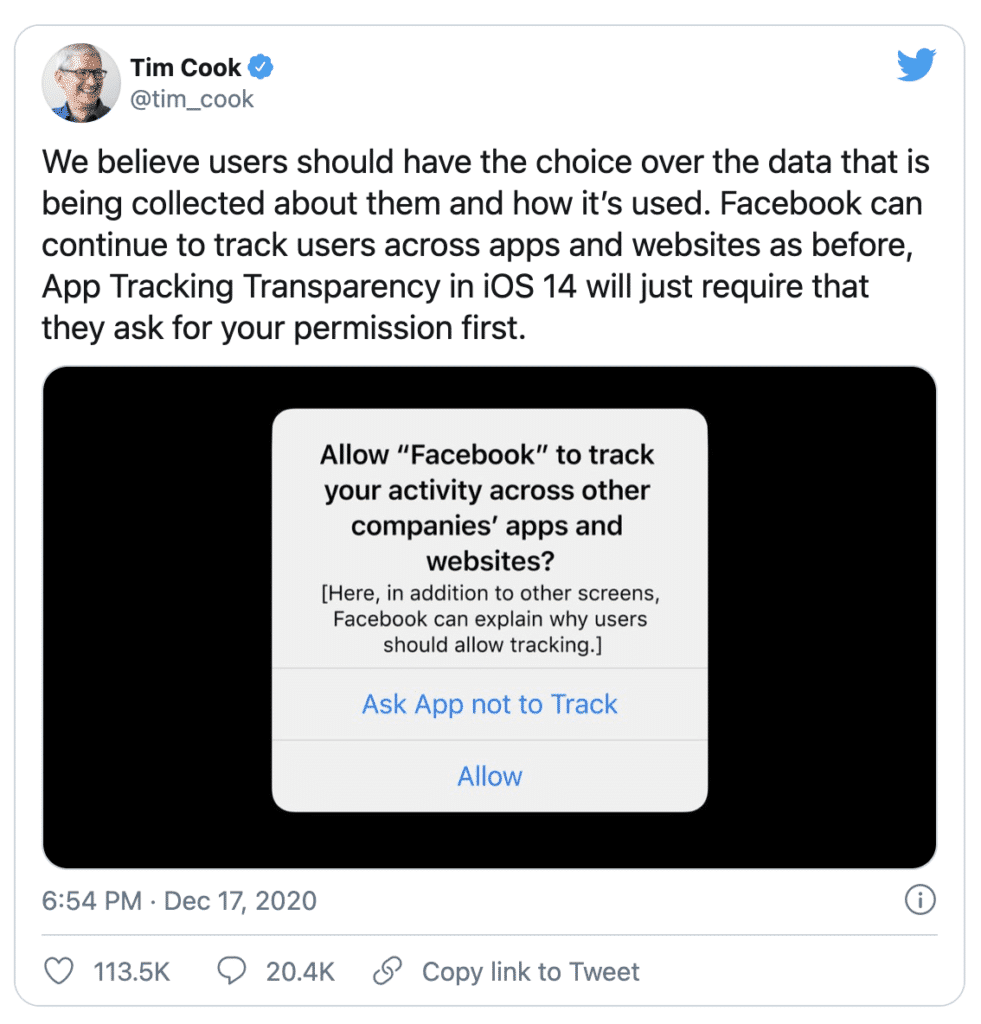Ever buy something online yet the seller never sends you the shipping information with the tracking code? You have no idea when your item will arrive, where it’s coming from, or if it was even shipped.
Apple’s upcoming iOS 15 — available this Fall — will include a new feature called Mail Privacy Protection that blocks relevant tracking information from being sent back to an Email Marketing Platform and used by a marketing team to determine the open rates of emails they send.
This “feature” — within Apple Mail on the upcoming iOS, iPadOS, and macOS releases — “Stops senders from using invisible pixels to collect information about the user. The new feature helps users prevent senders from knowing when they open an email and masks their IP address so it can’t be linked to other online activity or used to determine their location.” (Apple)
Basically, it’s going to be impossible to get accurate open rates from subscribers using Apple Mail. Is this a real shake-up in email marketing? Keep reading to find out.
Privacy Within iOS
Apple has touted improved privacy features for some time now. With last year’s iOS 14, Apple added additional privacy controls, along with the ability to limit how much of a user’s data is shared with companies.
In iOS 14.5 Apple released its App Tracking Transparency (ATT) privacy feature that requires apps to request the user’s permission before collecting their data. They provided the ability for a user to opt-out of IDFA (identifier for advertisers) and take control over an apps’ use of their activities and behavior.

Craig Federighi, Senior VP of Software Engineering at Apple told The Wall Street Journal regarding ATT, “We really just want to give users a choice. [Mobile] devices are so intimately a part of our lives and contain so much of what we’re thinking and where we’ve been, and who we’ve been with, that users deserve and need control of that information.”
This concept of allowing customers to control their data has been growing over the past several years, notably with GDPR in Europe, PDPA in Singapore, and the CCPA in the US. Apple’s Safari and Mozilla’s Firefox now block third-party cookies, and Google plans to eliminate them by 2022, reducing the amount of data that can be used to target customers.
How Does Mail Privacy Protection Work?
Although it may not be turned on by default in the upcoming iOS release, the Mail app will include the Mail Privacy Protection option that prevents the use of pixels to gather information about the recipient, including whether the email has been opened or not. Users will have to opt-in to this Apple Mail feature once the updated OS goes live.

The two major features to Mail Privacy Protection are:
- Open tracking prevention: this works by Apple downloading remote content in the background to prevent accurate tracking of opens.
- IP Protection: Mail will download remote content through a series of proxy servers to hide the IP address of the subscriber.
The Mail app previously allowed subscribers to block email trackers by stopping the remote content from loading, but with Mail Privacy Protection, Apple loads the remote content for subscribers automatically. This has been a default feature inside of Gmail, Outlook, and Yahoo! Mail unless the subscriber opted to load the email images.
Subscribers will be able to view your entire email, in all its glory, including your CTAs, without the need to select “load images.” The downside is that you won’t know whether they opened your email.

Here’s the official statement from Apple regarding Mail Privacy Protection:
“When you receive an email in the Mail app, rather than downloading remote content when you open an email, Mail Privacy Protection downloads remote content in the background by default – regardless of how you do or don’t engage with the email. Apple does not learn any information about the content.
In addition, all remote content downloaded by Mail is routed through multiple proxy servers, preventing the sender from learning your IP address. Rather than share your IP address, which can allow the email sender to learn your location, Apple’s proxy network will randomly assign an IP address that corresponds only to the region your device is in. As a result, email senders will only receive generic information rather than information about your behavior. Apple does not access your IP address.”
Why Mail Privacy Protection Isn’t Exactly New
Based on our internal tests using iOS 15, this Mail Privacy Protection feature isn’t all that different from what Gmail has been doing since 2013.
Before Gmail sends an email to a subscriber, their server loads the images within the email, which may cause email marketing platforms to send false-positive results. Gmail proxy servers also send incorrect information to email marketing platforms regarding the device and location of the email subscriber.
Because of Gmail’s proxy and the current email image blocking from service providers, it has been impossible for a while now to get the most accurate email open rate metrics.
How Does Apple’s Mail Privacy Protection Affect You?
As a sender, subscribers using Apple’s Mail Privacy Protection will stop you from:
- Knowing whether a subscriber opened your email or not (more than likely you’ll have a higher than normal open rate for those using Apple Mail)
- Knowing the location of a subscriber
- Knowing the device your subscriber uses to read your email (although you can guess that’s it’s an Apple device)
- You won’t have accurate open reporting for MPP protected recipients
What does this all mean? Basically, you’ll have a less accurate open rate than before. Since roughly 11-13% of email subscribers use Apple Mail, you can be sure that your email open rates will be off by at least 11-13%.
Just know that these updates only affect the Apple Mail app. If subscribers use the Gmail app, Outlook, or any other numerous email applications to get their email, this change will not affect them.
What Should You Do?
So, should you panic? Is everything over with email?
Far from it.
For those using the Emarsys CEP (Customer Engagement Platform), just know that clicks are attributed to opens automatically. This means that when the subscriber clicks the email, but the platform isn’t informed of an open, it’s automatically tagged that it was opened.
Here are some things you should do to make certain you are ahead of your competition once iOS 15 is available for iPhone users to download:
- Review your automation programs and consider adjusting some of your nodes that use email open events (for example, campaigns with follow-up emails that are sent out to subscribers who have yet to open your first email).
- For those using the Emarsys CEP, be sure to visit this page to understand how MPP may affect your campaigns.
- Create a campaign, informing customers — potentially those with a .icloud, .me, .mac address — of the upcoming changes and how it might affect them.
The good news is that this security feature does not affect tracking clicks within your email. You can also continue using your zero- and first-party data to deliver unique, personalized experiences for your customers, across each and every channel, so you can connect with buyers at the right moment and on the right device.
Final Thoughts
Apple has been pushing privacy for some time… but will others follow? Although this isn’t some radical new technology and is somewhat similar to the Gmail proxy that was implemented in 2013, will Google follow with an update of their own?
Open rates are NOT the all-defining attribute associated with emails. In fact, open rates have been unreliable for many years and you shouldn’t rely solely on them when measuring your email performance.
We will continue to monitor Apple’s updates around Mail Privacy Protection to keep you updated with marketing best practices for your future success. From what we know right now, your open rates for those using Apple Mail may be much higher with the upcoming OS update.
Handpicked Related Content











